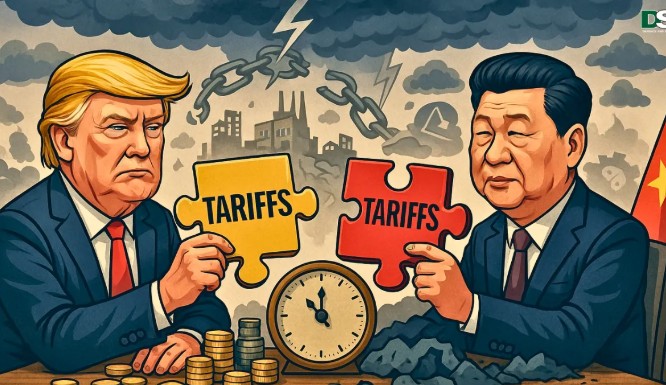
U.S.–China Tariff Overview and Pause Timeline
The U.S.–China trade war has evolved over several years, with tariffs imposed, adjusted, and paused at various points. The latest development includes a 90-day tariff pause, announced in May 2025, aimed at easing tensions and allowing further negotiations.
Current U.S. Tariff Structure on Chinese Imports
The U.S. has imposed tariffs on a wide range of Chinese goods, with rates reaching up to 245% in some cases. These tariffs fall into several categories:
- Reciprocal Tariffs: Initially set at 125%, later reduced to 10% during the pause.
- Fentanyl-Linked Tariffs: A 20% tariff remains in place due to concerns over fentanyl production.
- Sector-Specific Tariffs: Additional duties ranging from 7.5% to 100% on electronics, semiconductors, and pharmaceuticals.
China’s Response
China has also imposed retaliatory tariffs, though it has reduced its rates in response to the pause:
- Tariffs on U.S. goods: Lowered from 125% to 10%.
- Export bans: Restrictions on critical minerals and rare earths.
- WTO complaint: China has filed a formal complaint against U.S. tariff actions.
Pause Timeline by Product
The 90-day tariff pause, announced on May 12, 2025, applies to several key product categories:
Product Category Previous Tariff Rate Paused Tariff Rate Pause Expiration Semiconductors & Electronics 145% 30% August 12, 2025 Automobiles & Auto Parts 125% 10% August 12, 2025 Steel & Aluminum 50% 25% August 12, 2025 Pharmaceuticals 100% 30% August 12, 2025 Agricultural Products 84% 34% August 12, 2025
Impact on Key Industries
1. Automotive Industry
The auto sector faced uncertainty due to China’s rare earth export restrictions, which are crucial for electric vehicle (EV) motors and cameras. Major automakers like GM, Ford, and Toyota urged action to prevent supply chain disruptions. Some manufacturers even paused production due to shortages.
2. Steel and Aluminum Businesses
Trump doubled tariffs on steel and aluminum imports to 50%, affecting industries reliant on these materials. Canadian steel and aluminum producers expressed concerns over rising costs, while U.S. businesses scrambled to find alternative suppliers.
3. Home Appliances and Consumer Goods
Higher tariffs on imported steel and aluminum led to price hikes for refrigerators, dishwashers, and washing machines. Experts advised consumers to buy appliances sooner rather than later to avoid future cost increases.
4. Supply Chain and Logistics
The global supply chain struggled with demand forecasting due to tariff uncertainty. Companies reduced purchasing activities, leading to lower transportation rates and financial strain on logistics firms.
Future Outlook
While the pause provides temporary relief, the core tariffs—such as those related to national security (Section 232) and fentanyl production (IEEPA)—remain in place. The U.S. has signaled that tariffs could be reinstated if negotiations do not yield a final resolution.
Key Events Leading Up to These Tariffs
The U.S.–China trade war has been shaped by several major events over the years:
- July 2018: The U.S. imposes 25% tariffs on $34 billion worth of Chinese imports, including cars and aircraft parts. China retaliates with 25% tariffs on U.S. agricultural products.
- September 2018: The U.S. expands tariffs to $200 billion worth of Chinese goods, prompting China to impose duties on $60 billion of U.S. exports.
- January 2020: A Phase One trade deal is signed, temporarily reducing tensions but failing to resolve deeper trade disputes.
- April 2025: The U.S. raises tariffs to 125%, targeting Chinese electronics, agriculture, and auto parts.
- May 12, 2025: The 90-day tariff pause is announced in Geneva, reducing tariffs on both sides and creating space for further negotiations.
- June 2025: Trump doubles steel and aluminum tariffs to 50%, citing national security concerns.
Additional Extensions on Technology Tariffs
The U.S. Trade Representative (USTR) announced an extension of tariff exemptions on certain Chinese technology imports through August 31, 2025. These exemptions apply to 164 Chinese goods, including:
- Semiconductor components
- Telecommunications hardware
- Aerospace items
- Medical device parts
Additionally, 14 categories of Chinese solar panel manufacturing equipment, such as wafer slicers and module laminators, were granted exemptions in September 2024, and these have also been extended. The decision follows a tentative trade agreement reached in May 2025, which suspended most new tariffs for 90 days, maintaining a baseline 10% rate on mutual imports.
However, tensions remain high, with both the U.S. and China accusing each other of violating trade agreements. The U.S. has criticized China for failing to roll back export controls on key industrial products, such as rare-earth minerals and magnets, while China has pushed back against U.S. restrictions on chip design software sales and visa cancellations for Chinese nationals.
How Businesses Can Stay Strong During Tariff Challenges
Businesses facing tariff uncertainty must take proactive steps to adapt and thrive in this evolving trade landscape. Here are some key strategies:
- Understand Your Supply Chain Companies should conduct a thorough audit of their supply chains to identify vulnerabilities and explore alternative sourcing options.
- Diversify Suppliers Businesses should seek new suppliers in countries like Vietnam, India, and Mexico to reduce dependency on Chinese imports.
- Stockpile Inventory Many firms are increasing stock levels of critical imports to avoid sudden price hikes when tariffs resume.
- Strategic Purchasing Companies are accelerating orders to take advantage of the temporary tariff relief before potential reinstatement.
- Scenario Planning Businesses should run cost impact analyses to determine how tariff changes will affect pricing and profitability.
- Lobbying Efforts Industry groups are pressuring lawmakers to extend tariff exemptions or negotiate more favorable trade terms.
- Invest in Domestic Production Some companies, particularly in semiconductors and electronics, are ramping up U.S.-based manufacturing to reduce reliance on foreign imports.
- Explore New Markets Businesses should consider expanding into alternative markets to offset losses from Chinese trade restrictions.
- Leverage Technology Companies can use AI-driven analytics to optimize supply chain efficiency and predict future tariff impacts.
- Stay Informed Keeping up with policy changes and engaging with industry associations can provide valuable insights and support.
